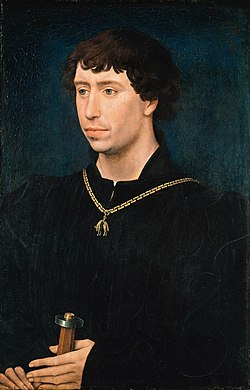
Back Karel die Stoute Afrikaans Karl der Kühne ALS شارل الجريء Arabic شارل التانى (الجرىء) ARZ Carlos el Temerariu AST Cəsur Karl Azerbaijani چارلز مارتین AZB Карл Смелы Byelorussian Шарл Дръзки Bulgarian Charlez an Her Breton
| Charles the Bold | |||||
|---|---|---|---|---|---|
 Charles the Bold in about 1461–1462, wearing the collar of the Order of the Golden Fleece, painted by Rogier van der Weyden | |||||
| Duke of Burgundy | |||||
| Reign | 15 June 1467 – 5 January 1477 | ||||
| Predecessor | Philip the Good | ||||
| Successor | Mary the Rich | ||||
| Born | 10 November 1433 Dijon, Burgundy | ||||
| Died | 5 January 1477 (aged 43) Nancy, Lorraine | ||||
| Burial | |||||
| Spouses | |||||
| Issue | Mary the Rich | ||||
| |||||
| House | Valois-Burgundy | ||||
| Father | Philip the Good | ||||
| Mother | Isabella of Portugal | ||||
| Religion | Roman Catholicism | ||||
| Signature | |||||
Charles Martin (10 November 1433 – 5 January 1477), called the Bold,[a] was the last duke of Burgundy from the House of Valois-Burgundy, ruling from 1467 to 1477. He was the only surviving legitimate son of Philip the Good and his third wife, Isabella of Portugal. As heir and as ruler, Charles vied for power and influence with rivals such as his overlord, King Louis XI of France. In 1465 Charles led a successful revolt of Louis's vassals in the War of the Public Weal.
After becoming the Duke of Burgundy in 1467, Charles pursued his ambitions for a kingdom, independent from France, that would stretch contiguously from the North Sea in the north to the borders of Savoy in the south. For this purpose, he acquired Guelders and Upper Alsace; sought the title King of the Romans; and gradually became an enemy of the Germans. Charles married Margaret of York for an English alliance. He arranged the betrothal between his sole child, Mary, with Maximilian of Austria.
A passionate musician and patron of the arts, Charles supported the production of illuminated manuscripts and music. His court was famously known as a centre of arts, chivalry, and etiquette. He was obsessed with order and regulation and issued many ordinances throughout his rule, dictating military matters, legislation, and diplomacy in the minutest detail. Charles was religious and his patron saint was Saint George. He turned down multiple requests from the pope and the Venetians to undertake a crusade against the Ottoman Turks.
Towards the end of his life, Charles became engaged in a multi-national conflict called the Burgundian Wars (1474–1477), where he fought to retain ownership of Upper Alsace against an alliance of Swiss, German, and Alsatian polities called the Lower League. After his unsuccessful siege of Neuss, he was defeated by the Swiss at the battles of Grandson and Morat. Charles was killed during the Battle of Nancy on 5 January 1477, fighting against Duke René II of Lorraine and his Swiss army. His death triggered the War of the Burgundian Succession and led to the end of the Burgundian State. Charles's daughter, Mary, was the last of Charles's dynasty. Mary's son, Philip of Austria, inherited the Burgundian Netherlands.
- ^ a b Van Loo 2021, p. 287.
- ^ Vaughan & Paravicini 2002, p. 167.
Cite error: There are <ref group=lower-alpha> tags or {{efn}} templates on this page, but the references will not show without a {{reflist|group=lower-alpha}} template or {{notelist}} template (see the help page).